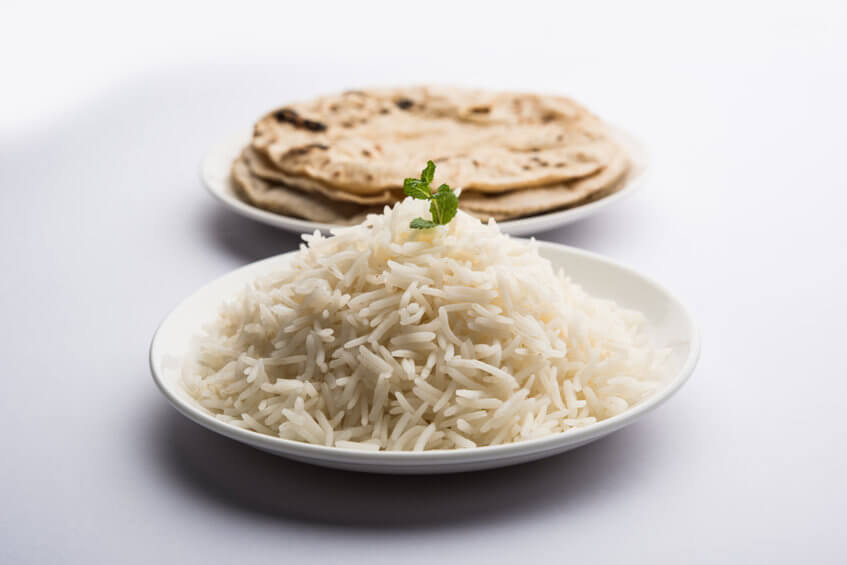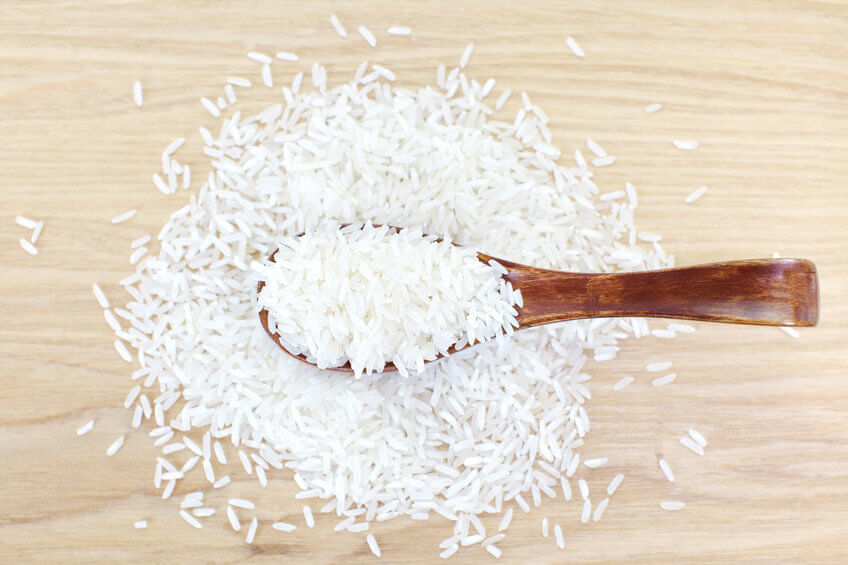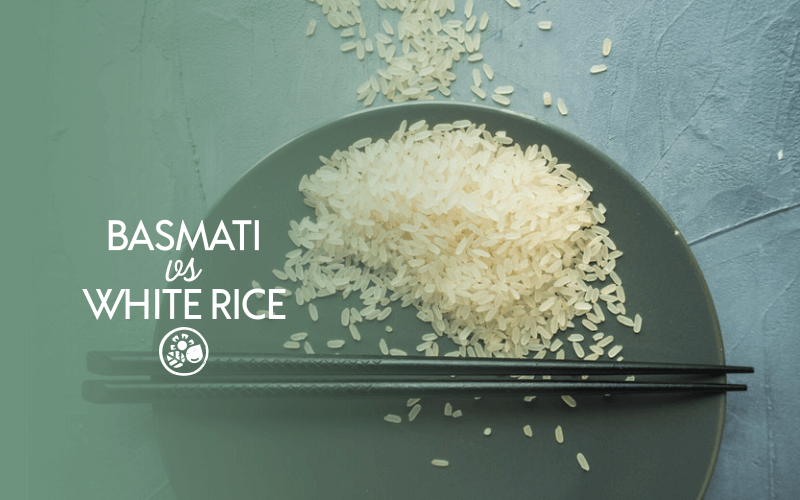Did you know there are more than 120,000 varieties of rice in the world? No wonder the rice aisle can be so overwhelming! Brown rice, white rice, basmati rice, jasmine rice, wild rice, even red or black rice—there is no shortage of options at the modern grocery store. Today, we’re going to talk about two of the most common types: let’s compare basmati rice vs white rice.
In short, the main difference between Basmati rice vs white rice is that Basmati rice is a variety of white rice that has a lower GI, less arsenic, more fiber, and more of an aroma. White rice, on the other hand, has less calories and a more neutral aroma.
Basmati Rice

Basmati rice is most often seen in traditional Indian cuisine; in fact, the name itself comes from a Sanskrit word that means “fragrant.” Characterized by long, slender, “pointy” grains, this wonderfully aromatic rice is traditionally grown in parts of India and Pakistan. The genetic ancestors of this variety likely date back to at least 2000 BC, and it has been a food staple in South Asian cuisine for centuries.
White Rice

Technically, any variety of rice can become white rice. What we commonly refer to as “white rice” is simply rice that has been milled to remove the bran and germ layers, then further processed and polished into the fluffy, snow-white grain we all know and love.
When you buy rice at a grocery store in the United States that is labeled “white rice,” it is often an unnamed, US-grown variety of medium or long-grain rice.
Another common type of white rice purchased in the US is white jasmine rice.
Which Type of Rice Is Healthier?
Let’s talk about the various health benefits and potential downsides present in basmati rice vs. white rice. If you’re concerned about nutrition, which type of rice should you choose?
Basmati Rice Has a Lower GI
If you or someone you love has been diagnosed with diabetes, basmati rice is your best option—it actually has the lowest glycemic index of any rice, coming in at 50-58 on the GI scale.
Compare that with your average white rice, which has a glycemic index of 79-109 (depending on the brand and preparation method.)
This makes basmati rice an obvious choice if you have any concerns about the effect rice may have on your blood sugar levels.
Resistant Starch in White Rice
Resistant starch is a type of starch that, like fiber, cannot be digested or absorbed by your body.
Some types of resistant starch can even be fermented by gut microbes in the colon, which helps trigger your body to begin burning fat.
One recent study showed that cooking, then cooling white rice upped the amount of resistant starch present — even when the rice was later reheated.
This resistant starch content also greatly lowered the glycemic effect of the rice, meaning that it did not have the same effect on blood sugars as freshly cooked rice.
If you struggle with diabetes but you prefer white rice to basmati rice, you can precook your white rice, refrigerate it for 24 hours, and then reheat it. This will raise the amount of resistant starch and help to better moderate your blood sugar response.
Some Types of Basmati Rice Are High in Fiber
One reason that basmati rice comes in lower on the glycemic index is that it is relatively high in fiber: 1 cup of some varieties of basmati rice can have as much as 8 grams of fiber.
The same serving of a typical white rice variety usually only has less than a gram of fiber (about 0.7 grams.)
A diet high in fiber can help your digestion by preventing constipation, as well as helping to lower the risk of developing Type II Diabetes and some types of cancer.
White Rice Is Easier to Digest
Whole grains can be difficult for the body to digest, especially if they are not prepared properly.
Many sources suggest basmati rice needs to be soaked up to two hours before cooking, which helps make it more easily digestible.
White rice, however, is much easier on the digestive system! Because the bran and germ have been removed, you don’t need to worry about soaking white rice.
This cuts down on your overall cook time and gives your digestive system a bit of a break.
In Eastern Medicine, white rice is seen as having beneficial qualities and characteristics. Ayurvedic medicine (the ancient Indian healing practices) and Traditional Chinese Medicine both consider white rice a “yin,” or “cooling” food.
In both of these ancient practices, white rice is known for helping rid the body of excess heat and settling the digestive system. This could be of benefit to anyone struggling with digestive issues, such as gas, bloating, or indigestion.
Basmati Rice Is Lowest in Arsenic

Because rice is grown in paddies that are flooded with water, arsenic can be a big concern. This is because arsenic is often present in groundwater, and this natural element can be toxic if too much is ingested.
Researchers have found that basmati rice has the lowest arsenic content of any rice variety, and that amount is lowered even more if you soak your basmati rice (as is recommended.)
According to the study, white rice is higher in arsenic, however, you can lower the amount by soaking it for at least 30 minutes before cooking.
White Rice Has Fewer Calories
If you’re counting your calories, you may want to choose white rice over basmati rice. Basmati rice has about 160 calories per serving, whereas white rice only has about 103 calories per serving.
When you’re tracking your calories and trying to stay in a caloric deficit, every single calorie matters—so that difference of 57 calories can’t be ignored!
Culinary Differences of Basmati Rice vs White Rice
Let’s have a look at some of the differences between Basmati rice vs white rice as it relates to practical use.
Appearance
Regardless of whether you buy brown or white Basmati rice, the overall look is about the same—long, slender, pointy grains.
The Indian government actually has strict regulations for the rice produced in their country; a crop of rice must meet specific length and width requirements in order to be labeled “basmati rice.”
Basmati also often doubles in length when cooked, but the width stays the same. It’s often cooked with saffron or turmeric, both of which give it a pleasant golden color that you may associate with this grain.
White rice, especially in the United States, is often a medium or long-grain variety of rice that may not actually be named on the packaging. Whether it’s medium or long-grain, it will likely be shorter and rounder than basmati rice (which makes it easy to tell the difference between the two.)
Smell
Most white rice is not exactly known for its aroma.
That’s not to say it’s terrible, but rather, that it has very little smell to associate with it. This makes common white rice very versatile, but not very memorable.
Basmati, on the other hand, is known as being an aromatic rice variety (and, as we said earlier, its very name means “fragrant.”) The smell of basmati is distinctive, often compared to popcorn. This is definitely a pleasing attribute of this popular ancient grain.
In either case, the storage of basmati rice vs white rice is important—rice can lose its subtle aromas and flavors over time, so it’s important to store any kind of rice in an air-tight container. (This also means that it won’t adopt any smells or flavors from your pantry.)
Texture and Flavor
Basmati rice has a dry, yet light and fluffy texture that makes a great base for the thick curries and sauces of typical Southeast Asian food. The grains stay separate after cooking, which makes this rice easy to identify in its cooked state.
Basmati rice is known for its “nutty” and sometimes lightly-floral flavor and can be cooked with aromatics like saffron, turmeric, or even cinnamon and cardamom. It has a flavor profile that is complex enough to be enjoyed plain, but simple enough to not overpower anything it’s paired with.
White rice has a higher starch content than basmati rice, making it a slightly stickier variety (although it is not as sticky as options such as Japanese sushi rice.) The slight stickiness makes this type of rice perfect for casseroles, stir-fries, puddings, and stuffing. The flavor is mostly neutral, meaning that whatever you pair with it will have the opportunity to shine.
One way to add more flavor to plain white rice is by changing what you cook it in: using stock, broth, or even coconut milk instead of water will infuse your white rice with more flavor.
Conclusion
In the debate about basmati rice vs white rice, it really comes down to your personal preferences and needs. Are you watching your blood sugar, or are you counting calories? Is rice the star of your meal, or do you need it to complement the bolder flavors of your main dish?
All of these factors have to come into consideration when you’re deciding between these two delicious varieties of rice. Honestly, they are both great additions to your pantry, and it never hurts to have either of them on hand so you’re ready to prepare whatever culinary delight fits your mood!

